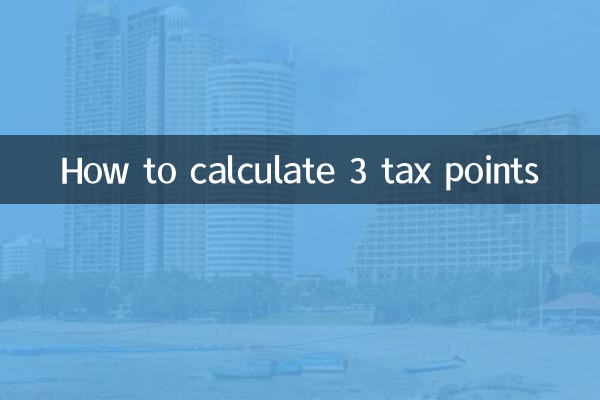How to calculate 3 tax points
Recently, the topic of tax calculation has become increasingly popular on social media and financial forums. In particular, "how to calculate the three tax points" has become the focus of many taxpayers. This article will combine popular discussions across the Internet to structurally analyze the core points of tax calculation, and provide practical cases and data tables to help readers quickly master the calculation method.
1. What is a tax point?

Tax point usually refers to the percentage calculation unit of tax, such as value-added tax, personal income tax, etc. The three tax points are a tax rate of 3%, which is common in small transactions or service fees. The following is a comparison of tax point applications in different scenarios:
| scene | Common tax points | Calculation formula |
|---|---|---|
| Small labor fee | 3% | Amount×3% |
| Simple collection of value-added tax | 3% or 5% | Sales×3% |
| Individual industrial and commercial household income tax | 1%-3% | Profit × approved tax rate |
2. Specific calculation cases for three tax points
1.Calculation of price including tax: If the product is priced at 1,000 yuan and an additional 3% tax is required, the total price = 1,000 + (1000 × 3%) = 1,030 yuan.
2.Separate calculation of taxes and fees: If the invoice shows a total price of 1,030 yuan (including 3% tax), then the tax amount = 1,030÷(1+3%)×3%≈30 yuan.
3.Personal income tax prepayment: If a freelancer earns a single income of 20,000 yuan, the personal tax is prepaid at 3% = 20,000 × 3% = 600 yuan.
| Calculation type | Example amount | 3% tax result |
|---|---|---|
| price including tax | 1,000 yuan | 30 yuan |
| Separation of taxes and fees | 1030 yuan | 30 yuan |
| Personal tax prepayment | 20,000 yuan | 600 yuan |
3. Answers to popular questions on the entire network
1.Can the tax point be reduced through negotiation?
According to the tax law, the statutory tax rate is not negotiable, but individual industrial and commercial households can reduce their actual tax burden through methods such as approved collection.
2.Does the 3% tax point apply to all industries?
No. For example, the simplified tax calculation for the construction industry is 3%, while general taxpayers in the service industry usually apply 6% or 9%.
3.How to avoid paying more tax?
It is necessary to accurately distinguish between tax-inclusive price and tax-exclusive price. The formula is: tax-exclusive price = tax-inclusive price ÷ (1 + tax rate).
4. Latest policy developments (hot spots in the past 10 days)
1. Taxation departments in many places have promoted the “One-click Calculation of 3% Tax” applet to simplify the declaration process for small and micro enterprises.
2. The State Council meeting emphasized that the preferential VAT rate of 3% will be extended until 2027, covering small and micro enterprises and individual industrial and commercial households.
3. There is a hot discussion on social platforms about "Whether the 3% tax point affects income", and experts recommend paying attentionPre-tax income agreementterms.
Summary: Mastering the calculation of three tax points requires clear applicable scenarios and calculation benchmarks, which can be quickly applied through structured data and cases. It is recommended that taxpayers pay attention to policy changes regularly and consult professional tax personnel when necessary.

check the details

check the details